Optical Spring Effect in Micro-Bubble Resonators and Its Application for the Effective Mass Measurement of Optomechanical Resonant Mode
Abstract
:1. Introduction
2. Theory of Optical Spring Effect in WGM Microcavity
3. Experiment and Result Analysis
4. Conclusions
Acknowledgments
Author Contributions
Conflicts of Interest
References
- Braginsky, V.B.; Manukin, A.B. Ponderomotive effects of electromagnetic radiation. Sov. Phys. JETP 1967, 25, 653–655. [Google Scholar]
- Braginsky, V.B.; Strigin, S.E.; Vyatchanin, S.P. Parametric oscillatory instability in Fabry–Perot interferometer. Phys. Lett. A 2001, 287, 331–338. [Google Scholar] [CrossRef]
- Carmon, T.; Rokhsari, H.; Yang, L.; Kippenberg, T.J.; Vahala, K.J. Temporal behavior of radiation-pressure-induced vibrations of an optical microcavity phonon mode. Phys. Rev. Lett. 2005, 94, 223902. [Google Scholar] [CrossRef] [PubMed]
- Zhang, M.; Wiederhecker, G.S.; Manipatruni, S.; Barnard, A.; McEuen, P.; Lipson, M. Synchronization of micromechanical oscillators using light. Phys. Rev. Lett. 2012, 109, 233906. [Google Scholar] [CrossRef] [PubMed]
- Lin, Q.; Rosenberg, J.; Chang, D.; Camacho, R.; Eichenfield, M.; Vahala, K.J.; Painter, O. Coherent mixing of mechanical excitations in nano-optomechanical structures. Nat. Photonics 2010, 4, 236–242. [Google Scholar] [CrossRef]
- Eichenfield, M.; Camacho, R.; Chan, J.; Vahala, K.J.; Painter, O. A picogram- and nanometre-scale photonic-crystal optomechanical cavity. Nature 2009, 459, 550–556. [Google Scholar] [CrossRef] [PubMed]
- Bahl, G.; Kim, K.H.; Lee, W.; Liu, J.; Fan, X.D.; Carmon, T. Brillouin cavity optomechanics with microfluidic devices. Nat. Commun. 2013, 4, 1994. [Google Scholar] [CrossRef] [PubMed]
- Han, K.W.; Zhu, K.Y.; Bahl, G. Opto-mechano-fluidic viscometer. Appl. Phys. Lett. 2014, 105, 014103. [Google Scholar] [CrossRef]
- Kim, K.H.; Bahl, G.; Lee, W.; Liu, J.; Tomes, M.; Fan, X.D.; Carmon, T. Cavity optomechanics on a microfluidic resonator with water and viscous liquids. Light 2013, 2, e110. [Google Scholar] [CrossRef]
- Chen, Z.M.; Li, M.; Wu, X.; Liu, L.Y.; Xu, L. 2-D optical/opto-mechanical microfluidic sensing with micro-bubble resonators. Opt. Express 2015, 23, 17659–17665. [Google Scholar] [CrossRef] [PubMed]
- Tian, F.; Zhou, G.Y.; Chau, F.S.; Deng, J. Torsional optical spring effect in coupled nanobeam photonic crystal cavities. Opt. Lett. 2014, 39, 6289–6292. [Google Scholar] [CrossRef] [PubMed]
- Schliesser, A.; Anetsberger, G.; Rivière, R.; Arcizet, O.; Kippenberg, T.J. High-sensitivity monitoring of micromechanical vibration using optical whispering gallery mode resonators. New J. Phys. 2008, 10, 095015. [Google Scholar] [CrossRef]
- Hossein-Zadeh, M.; Rokhsari, H.; Hajimiri, A.; Vahala, K.J. Characterization of a radiation-pressure-driven micromechanical oscillator. Phys. Rev. A 2006, 74, 023813. [Google Scholar] [CrossRef]
- Hossein-Zadeh, M.; Vahala, K.J. Observation of optical spring effect in a microtoroidal optomechanical resonator. Opt. Lett. 2007, 32, 1611–1613. [Google Scholar] [CrossRef] [PubMed]
- Sheard, B.S.; Gray, M.B.; Mow-Lowry, C.M.; McClelland, D.E. Observation and characterization of an optical spring. Phys. Rev. A 2004, 69, 051801. [Google Scholar] [CrossRef]
- Vogel, M.; Mooser, C.; Karrai, K.; Warburton, R.J. Optically tunable mechanics of microlevers. Appl. Phys. Lett. 2003, 83, 1337–1339. [Google Scholar] [CrossRef]
- Tian, F.; Zhou, G.Y.; Du, Y.; Chau, F.S.; Deng, J. Optical spring effect in nanoelectromechanical systems. Appl. Phys. Lett. 2014, 105, 061115. [Google Scholar] [CrossRef]
- Yu, W.Y.; Jiang, W.C.; Lin, Q.; Lu, T. Cavity optomechanical spring sensing of single molecules. Nat. Commun. 2016, 7, 12311. [Google Scholar] [CrossRef] [PubMed]
- Kim, K.H.; Fan, X.D. Surface sensitive microfluidic optomechanical ring resonator sensors. Appl. Phys. Lett. 2014, 105, 191101. [Google Scholar] [CrossRef]
- Gohring, J.T.; Fan, X.D. Label free detection of CD4+ and CD8+ T cells using the optofluidic ring resonator. Sensors 2010, 10, 5798–5808. [Google Scholar] [CrossRef] [PubMed]
- Bianucci, P. Optical microbottle resonators for sensing. Sensors 2016, 16, 1841. [Google Scholar] [CrossRef] [PubMed]
- Kippenberg, T.J.; Vahala, K.J. Cavity opto-mechanics. Opt. Express 2007, 15, 17172–17205. [Google Scholar] [CrossRef] [PubMed]
- Schliesser, A.; Del’Haye, P.; Nooshi, N.; Vahala, K.J.; Kippenberg, T.J. Radiation pressure cooling of a micromechanical oscillator using dynamical backaction. Phys. Rev. Lett. 2006, 97, 243905. [Google Scholar] [CrossRef] [PubMed]
- Aspelmeyer, M.; Kippenberg, T.J.; Marquardt, F. Cavity optomechanics. Rev. Mod. Phys. 2014, 86, 1391–1452. [Google Scholar] [CrossRef]
- Gil-Santos, E.; Baker, C.; Nguyen, D.T.; Hease, W.; Gomez, C.; Lemaître, A.; Ducci, S.; Leo, G.; Favero, I. High-frequency nano-optomechanical disk resonators in liquids. Nat. Nanotechnol. 2015, 10, 810–817. [Google Scholar] [CrossRef] [PubMed]
- Li, M.; Wu, X.; Liu, L.Y.; Xu, L. Kerr parametric oscillations and frequency comb generation from dispersion compensated silica micro-bubble resonators. Opt. Express 2013, 21, 16908–16913. [Google Scholar] [CrossRef] [PubMed]
- Zhu, K.Y.; Han, K.W.; Carmon, T.; Fan, X.D.; Bahl, G. Opto-acoustic sensing of fluids and bioparticles with optomechanofluidic resonators. Eur. Phys. J. Spec. Top. 2014, 223, 1937–1947. [Google Scholar] [CrossRef]
- Lamb, H. On the vibrations of a spherical shell. Proc. Lond. Math. Soc. 1882, 14, 50–56. [Google Scholar] [CrossRef]
- Liu, F.F.; Alaie, S.; Leseman, Z.C.; Hossein-Zadeh, M. Sub-pg mass sensing and measurement with an optomechanical oscillator. Opt. Express 2013, 21, 19556–19567. [Google Scholar] [CrossRef] [PubMed]
- Liu, F.F.; Hossein-Zadeh, M. On the spectrum of radiation pressure driven optomechanical oscillator and its application in sensing. Opt. Commun. 2013, 294, 338–343. [Google Scholar] [CrossRef]
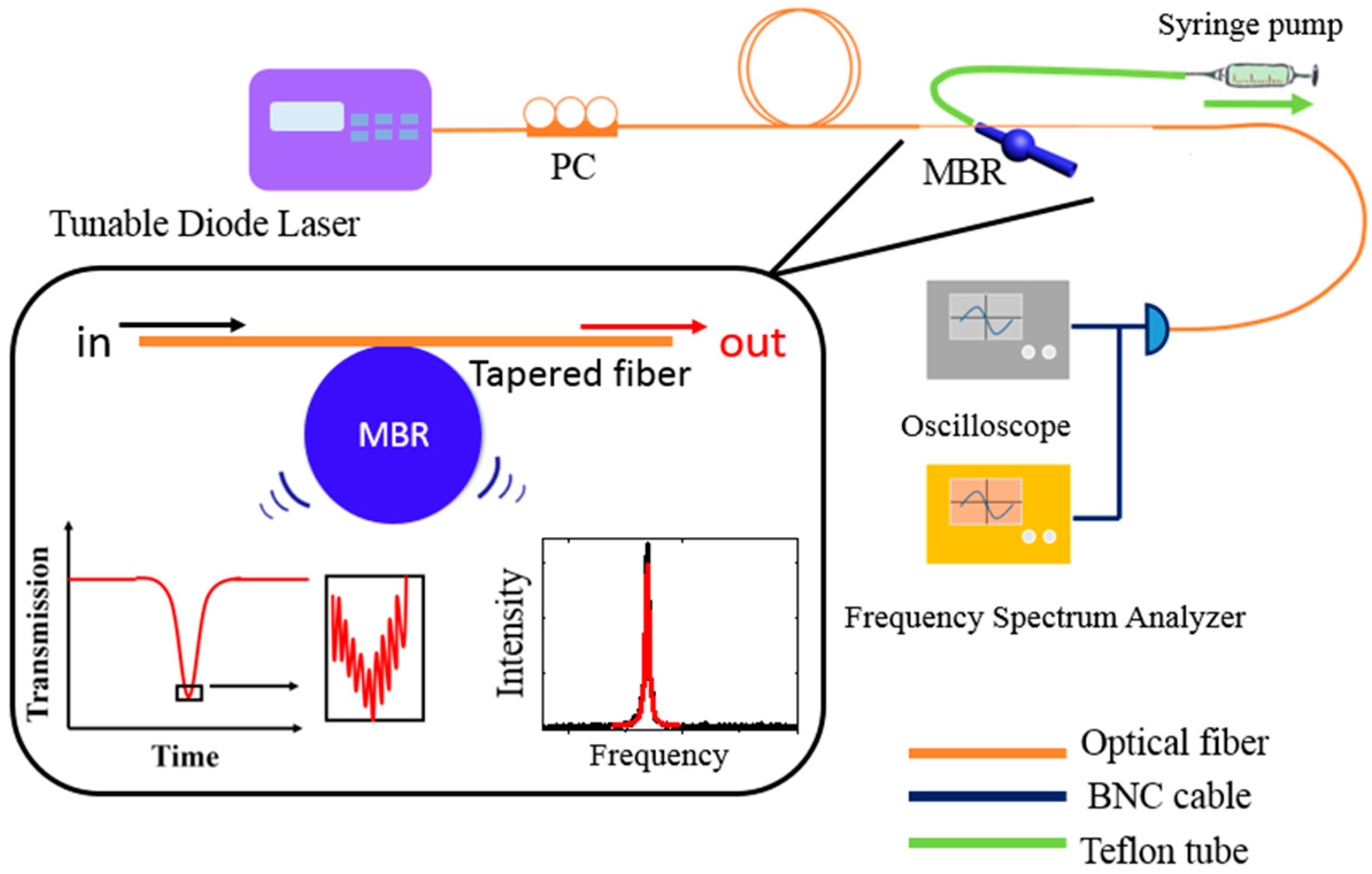
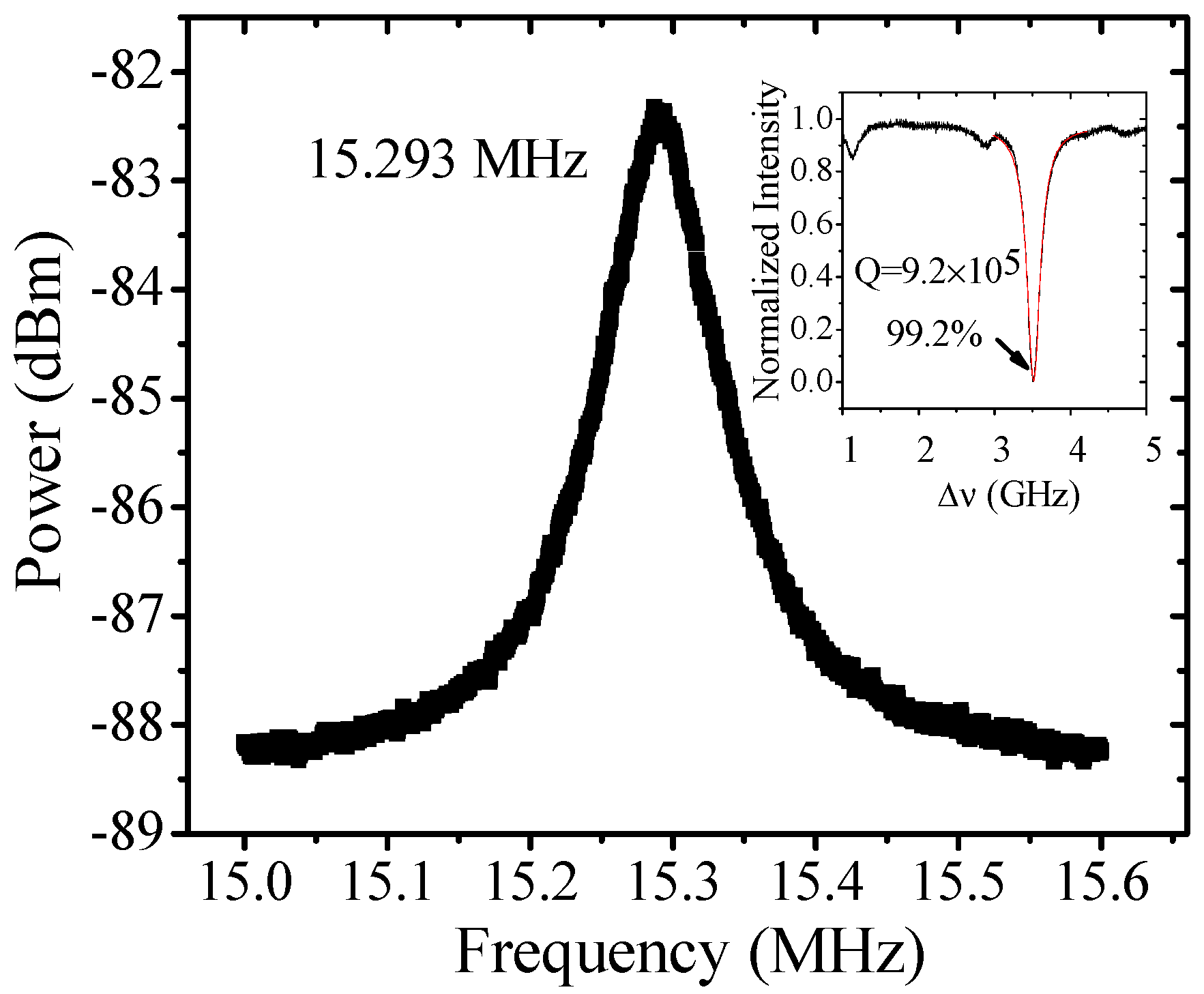
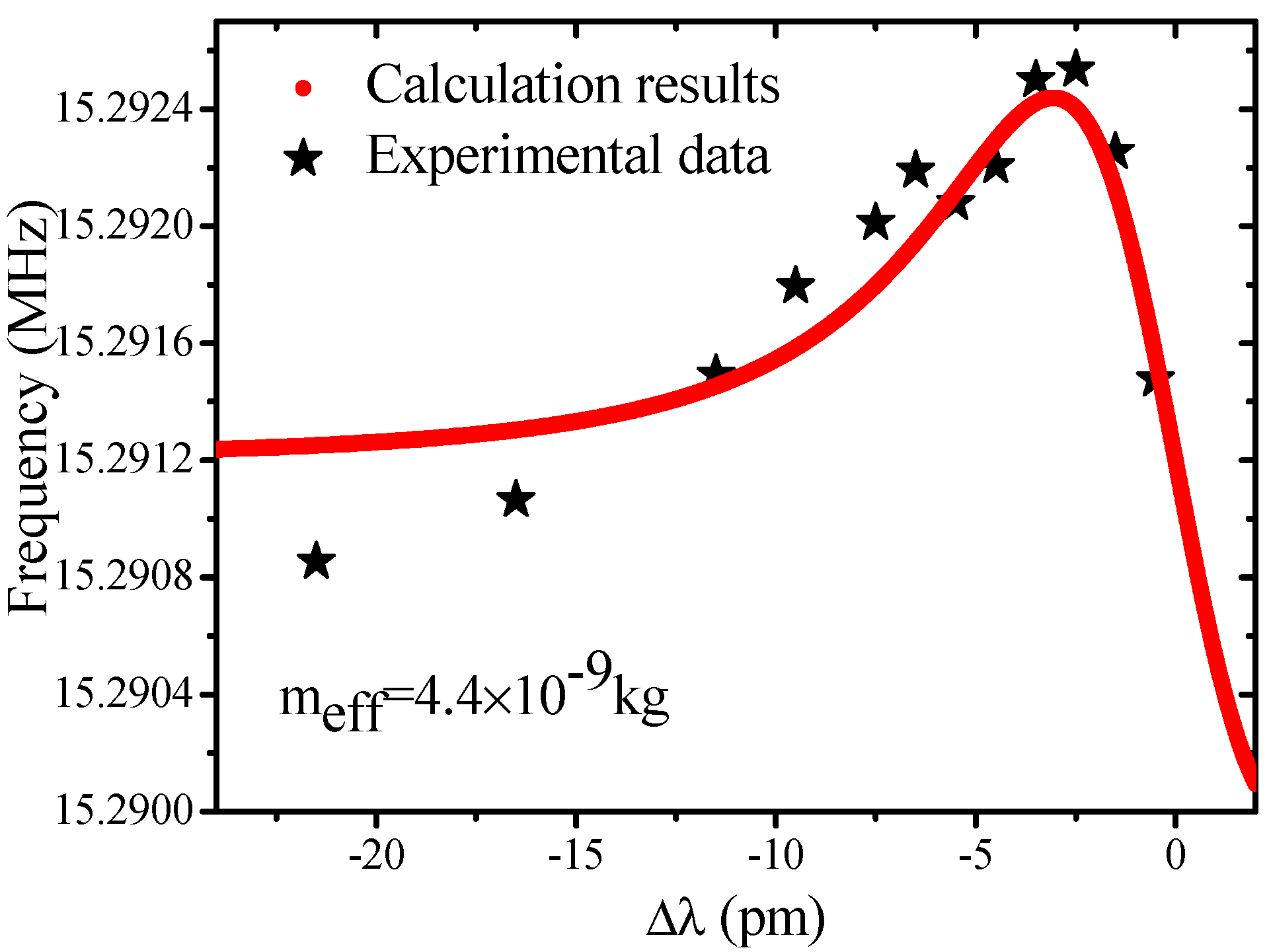

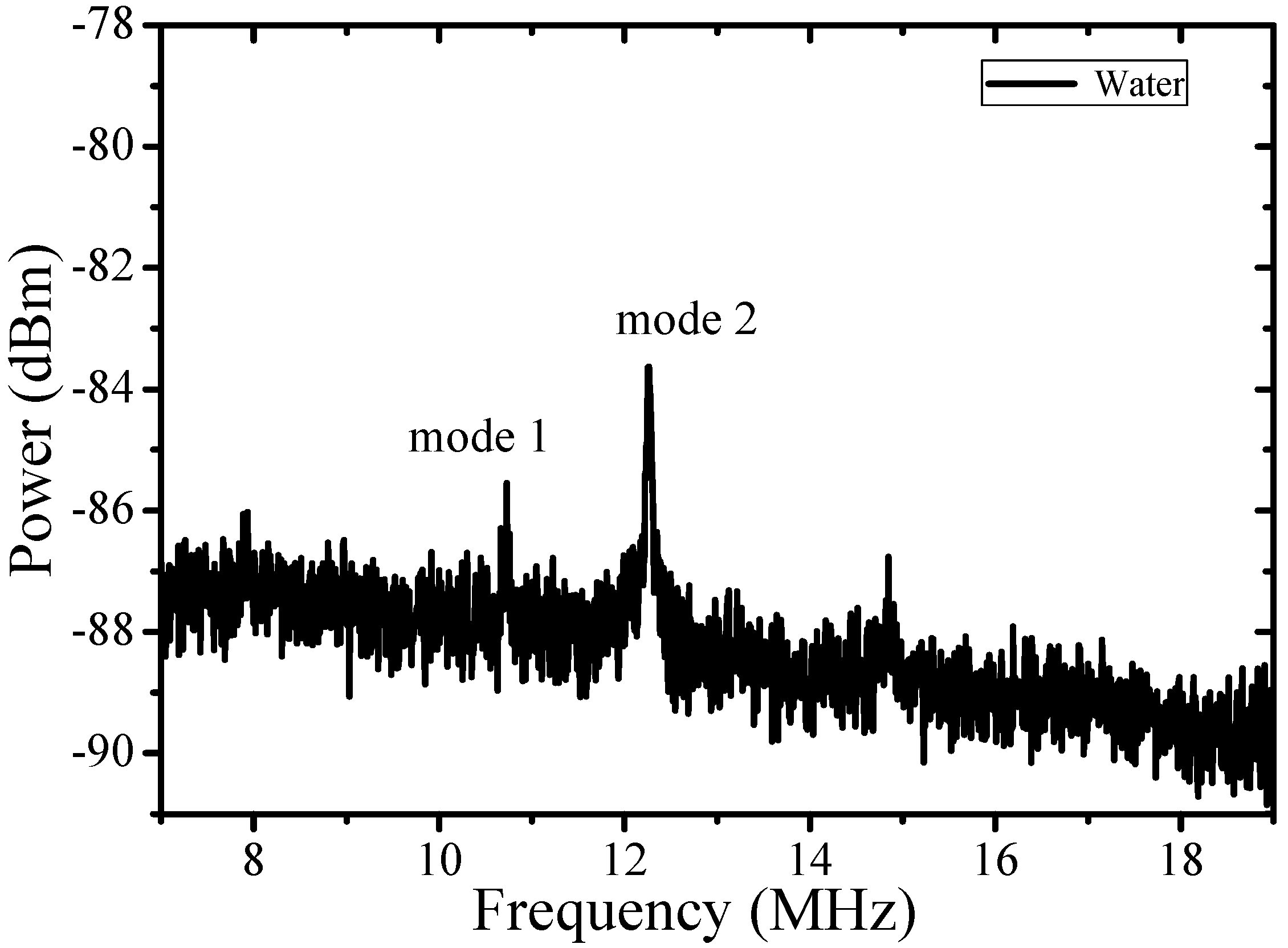

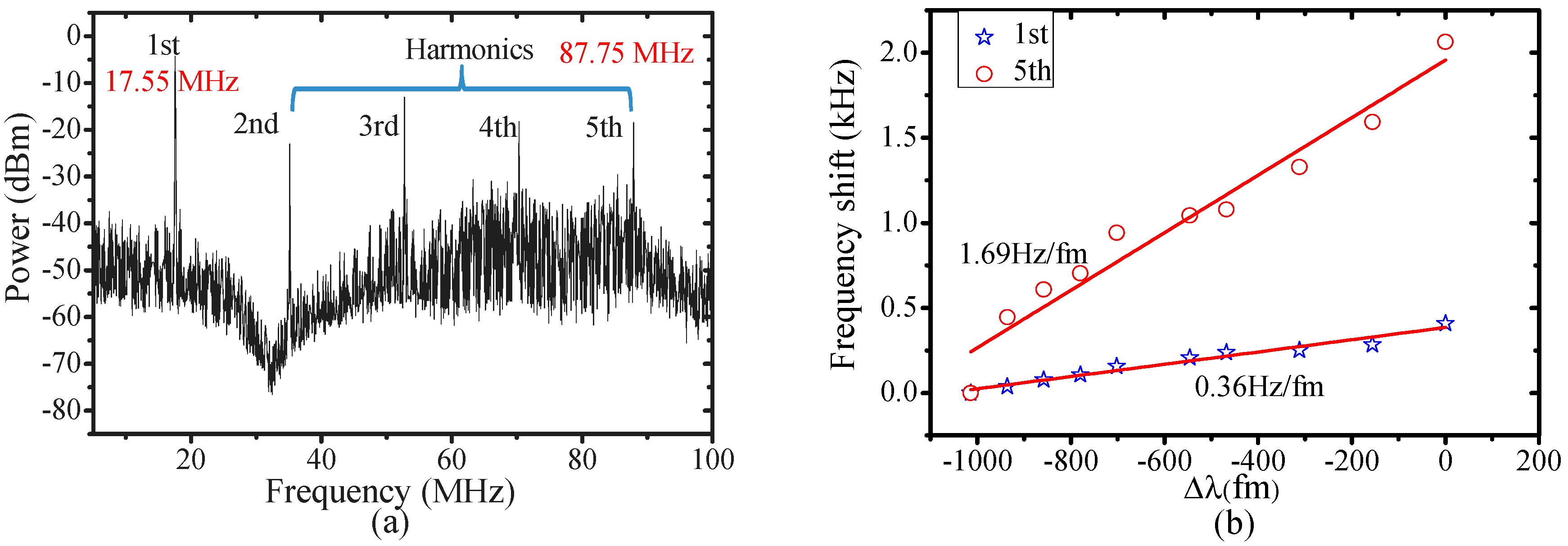
© 2017 by the authors. Licensee MDPI, Basel, Switzerland. This article is an open access article distributed under the terms and conditions of the Creative Commons Attribution (CC BY) license (http://creativecommons.org/licenses/by/4.0/).
Share and Cite
Chen, Z.; Wu, X.; Liu, L.; Xu, L. Optical Spring Effect in Micro-Bubble Resonators and Its Application for the Effective Mass Measurement of Optomechanical Resonant Mode. Sensors 2017, 17, 2256. https://doi.org/10.3390/s17102256
Chen Z, Wu X, Liu L, Xu L. Optical Spring Effect in Micro-Bubble Resonators and Its Application for the Effective Mass Measurement of Optomechanical Resonant Mode. Sensors. 2017; 17(10):2256. https://doi.org/10.3390/s17102256
Chicago/Turabian StyleChen, Zhenmin, Xiang Wu, Liying Liu, and Lei Xu. 2017. "Optical Spring Effect in Micro-Bubble Resonators and Its Application for the Effective Mass Measurement of Optomechanical Resonant Mode" Sensors 17, no. 10: 2256. https://doi.org/10.3390/s17102256



